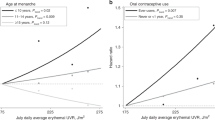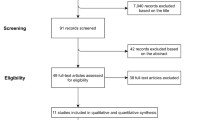Abstract
Objectives
Several studies suggest that hormonal mechanisms may be associated with the development of uveal melanoma. Therefore, the association between the risk of uveal melanoma and exposure to hormonal exposures was investigated in a case–control study from nine European countries.
Methods
Incident cases of uveal melanoma were frequency-matched to population and hospital controls by country, age, and sex. Female subjects were asked about their reproductive history, use of menopausal hormone replacement therapy and oral contraceptives. Among men, occupational handling of oils while working with transformers or capacitors which contain polychlorinated biphenyls (PCB) was solicited. Unconditional logistic regression analyses were calculated, adjusting for several potential confounders. Analyses were stratified by sex.
Results
Two hundred and ninety-three cases (165 men, 128 women) and 3,198 control subjects (2,121 men, 1,077 women) were interviewed. Among women, no associations were observed with hormonal status variables, intake of hormonal therapy or intake of oral contraceptives. Men showed an increased risk with occupational exposure to transformer/capacitor oils (OR = 2.74; Bonferroni-corrected 99.3% CI 1.07–7.02). However, these results were based on few exposed subjects only.
Conclusion
The results of this study do not support the hypothesis of a hormonal influence in the carcinogenesis of uveal melanoma. Our finding of a potentially increased risk with PCB-containing oils requires further research.
Similar content being viewed by others
References
Stang A, Parkin DM, Ferlay J, Jöckel KH (2005) International uveal melanoma incidence trends in view of a decreasing proportion of morphological verification. Int J Cancer 114:114–123
Kanter-Lewensohn L, Girnita L, Girnita A et al (2000) Tamoxifen-induced cell death in malignant melanoma cells: possible involvement of the insulin-like growth factor-1 (IGF-1) pathway. Mol Cell Endocrinol 165:131–137
Roberts JE, Wiechmann AF, Hu DN (2000) Melatonin receptors in human uveal melanocytes and melanoma cells. J Pineal Res 28:165–171
Hemminki K, Jiang Y (2001) Association of ocular melanoma with breast cancer but not with cutaneous melanoma: results from the Swedish Family-Cancer Database. Int J Cancer 94:907–909
Lea CS, Holly EA, Hartge P et al (2007) Reproductive risk factors for cutaneous melanoma in women: a case-control study. Am J Epidemiol 165:505–513
Hartge P, Tucker MA, Shields JA, Augsburger J, Hoover RN, Fraumeni JF Jr (1989) Case-control study of female hormones and eye melanoma. Cancer Res 49:4622–4625
Holly EA, Aston DA, Ahn DK, Kristiansen JJ, Char DH (1991) Uveal melanoma, hormonal and reproductive factors in women. Cancer Res 51(5):1370–1372
Stevens RG, Davis S (1996) The melatonin hypothesis: electric power and breast cancer. Environ Health Perspect 104(Suppl 1):135–140
Shah PN, Mhatre MC, Kothari LS (1984) Effect of melatonin on mammary carcinogenesis in intact and pinealectomized rats in varying photoperiods. Cancer Res 44(8):3403–3407
Behrens T, Lynge E, Cree I et al (2010) Occupational exposure to electromagnetic fields and sex-differential risk of uveal melanoma. Occ Environ Med (in press)
Bosetti C, Negri E, Fattore E, La VC (2003) Occupational exposure to polychlorinated biphenyls and cancer risk. Eur J Cancer Prev 12:251–255
Engel LS, Lan Q, Rothman N (2007) Polychlorinated biphenyls and non-Hodgkin lymphoma. Cancer Epidemiol Biomarkers Prev 16:373–376
Adenugba A, Khan SA, Taylor-Robinson SD et al (2009) Polychlorinated biphenyls in bile of patients with biliary tract cancer. Chemosphere 76:841–846
Hardell L, Van BB, Lindstrom G et al (2003) Increased concentrations of polychlorinated biphenyls, hexachlorobenzene, and chlordanes in mothers of men with testicular cancer. Environ Health Perspect 111:930–934
Bahn AK, Rosenwaike I, Hermann N, Grover P, Stellman J, O’Leary K (1976) Letter: melanoma after exposure to PCB’s. N Engl J Med 295:450
Sinks T, Steele G, Smith AB, Watkins K, Shults RA (1992) Mortality among workers exposed to polychlorinated biphenyls. Am J Epidemiol 136:389–398
Lynge E, Afonso N, Kaerlev L et al (2005) European multi-centre case-control study on risk factors for rare cancers of unknown aetiology. Eur J Cancer 41:601–612
Njor SH, Pedersen AT, Schwartz W, Hallas J, Lynge E (2009) Minimizing misclassification of hormone users at mammography screening. Int J Cancer 124:2159–2165
Gallagher RP, Elwood JM, Rootman J et al (1985) Risk factors for ocular melanoma: Western Canada Melanoma Study. J Natl Cancer Inst 74:775–778
Egan KM, Quinn JL, Gragoudas ES (1999) Childbearing history associated with improved survival in choroidal melanoma. Arch Ophthalmol 117(7):939–942
Bonefeld-Jorgensen EC, Andersen HR, Rasmussen TH, Vinggaard AM (2001) Effect of highly bioaccumulated polychlorinated biphenyl congeners on estrogen and androgen receptor activity. Toxicology 158:141–153
Ulbrich B, Stahlmann R (2004) Developmental toxicity of polychlorinated biphenyls (PCBs): a systematic review of experimental data. Arch Toxicol 78:252–268
Andric NL, Kostic TS, Zoric SN, Stanic BD, Andric SA, Kovacevic RZ (2006) Effect of a PCB-based transformer oil on testicular steroidogenesis and xenobiotic-metabolizing enzymes. Reprod Toxicol 22(1):102–110
Ajani UA, Seddon JM, Hsieh CC, Egan KM, Albert DM, Gragoudas ES (1992) Occupation and risk of uveal melanoma. An exploratory study. Cancer 70:2891–2900
Liljegren G, Hardell L, Lindstrom G, Dahl P, Magnuson A (1998) Case-control study on breast cancer and adipose tissue concentrations of congener specific polychlorinated biphenyls, DDE and hexachlorobenzene. Eur J Cancer Prev 7:135–140
Silver SR, Whelan EA, Deddens JA et al (2009) Occupational exposure to polychlorinated biphenyls and risk of breast cancer. Environ Health Perspect 117:276–282
McGlynn KA, Quraishi SM, Graubard BI, Weber JP, Rubertone MV, Erickson RL (2009) Polychlorinated biphenyls and risk of testicular germ cell tumors. Cancer Res 69:1901–1909
Monarrez-Espino J, Stang A, Bromen K, Merzenich H, Anastassiou G, Jöckel KH (2002) Occupation as a risk factor for uveal melanoma in Germany. Scand J Work Environ Health 28:270–277
Fortes C, de Vries E (2008) Nonsolar occupational risk factors for cutaneous melanoma. Int J Dermatol 47:319–328
Hakulinen T, Teppo L, Saxen E (1978) Cancer of the eye, a review of trends and differentials. World Health Stat Q 31:143–158
Shah CP, Weis E, Lajous M, Shields JA, Shields CL (2005) Intermittent and chronic ultraviolet light exposure and uveal melanoma: a meta-analysis. Ophthalmology 112:1599–1607
Li W, Judge H, Gragoudas ES, Seddon JM, Egan KM (2000) Patterns of tumor initiation in choroidal melanoma. Cancer Res 60(14):3757–3760
Lutz JM, Cree I, Sabroe S et al (2005) Occupational risks for uveal melanoma results from a case-control study in nine European countries. Cancer Causes Control 16:437–447
Acknowledgments
We gratefully acknowledge collaboration from patients, control subjects, participating hospitals, and data providers. “Occupational risk factors for rare cancers of unknown aetiology” was supported financially by the European Commission, DGXII, Programme BIOMED, grants no BMH1 CT 93-1630 and ERB CIPD CT 940285, and national funding agencies: Denmark: The strategic Environment Programme, grant no 92.01.015.7-06, and the Danish Epidemiology Science Centre,—the activities of the center are financed by a grant from the Danish National Research Foundation. France: Ligue Nationale contre le cancer, Fédération Nationale des Centres de Lutte contre le Cancer, Fondation de France, contract # 955368, Institut National de la Santé et de la Recherche Médicale (INSERM) contract Réseau en Santé Publique # 4R006A, French Ministry of Environment, contract # 237.01. 94.40182. Germany: Federal Ministry for Education, Science, Research and Technology (BMBF), grant no. 01-HP-684/8. Italy: The Italian Association for Cancer Research (AIRC), Special Project Oncology, Compagnia di San Paolo/FIRMS, MURST, Region Piedmont. Spain: Fondo de Investigación de la Sanitarie, Ministerio de Sanidad y Consumo, Unidad de Investigación Clinico-Epidemiológica, Hospital Dr. Peset. Generalitat Valenciana (FISS. 95/0044-01, 96/0043-01); Departmento de Sanidad y Consumo, Gobierno Vasco; Fondo de Investigación de la Sanitaria, Ministerio de Sanidad y Consumo, Ayuda a la Investigación del Departamento de Salud del Gobierno de Navarra. Sweden: Swedish Council for Work Life Research, Research Foundation of the Department of Oncology in Umeå, Swedish Society of Medicine, Lund University Hospital Research Foundation, Gunnar, Arvid and Elisabeth Nilsson Cancer Foundation, Örebro County Council Research Committee, Örebro Medical Center Research Foundation, John and Augusta Persson Foundation for Scientific Medical Research, Berta Kamprad Foundation for Cancer Research.
Author information
Authors and Affiliations
Corresponding author
Appendix
Appendix
The European study group on occupational causes of rare cancers
Denmark (Herman Autrup, Henrik Kolstad, Linda Kaerlev, Elsebeth Lynge, Jorn Olsen, Lisbeth Norum Pedersen, Svend Sabroe, Reference pathologists: Preben Johansen, Stein Poulsen, Peter Stubbe Teglbjaerg, Mogens Vyberg). France (Pascal Guénel, Joëlle Févotte and the members of the FRANCIM association: Patrick Arveux, Antoine Buemi, Paule-Marie Carli, Gilles Chaplain, Jean-Pierre Daurès, Jean Faivre, Pascale Grosclaude, Anne-Valérie Guizard, Michel Henry-Amar, Guy Launoy, Francois Ménégoz, Nicole Raverdy, Paul Schaffer). Germany (Wolfgang Ahrens, Cornelia Baumgardt-Elms, Thomas Behrens, Sibylle Gotthardt, Ingeborg Jahn, Karl-Heinz Jöckel, Hiltrud Merzenich, Nils Schmeißer, Andreas Stang, Christa Stegmaier, Antje Timmer, Hartwig Ziegler). Italy (Terri Ballard, Franco Bertoni, Giuseppe Gorini, Sandra Gostinicchi, Giovanna Masala, Enzo Merler, Franco Merletti, Lorenzo Richiardi, Lorenzo Simonato, Paola Zambon). Latvia (Irena Rogovska, Galina Sharkova, Aivars Stengrevics). Lithuania (Jolita Gibaviciene, Laimonas Jazukevicius, Juozas Kurtinaitis, Poma Pociute). Portugal (Noemia Alfonso, Altamiro Costa-Pereira, Sonia Doria, Carlos Lopes, José Manuel Lopes, Ana Miranda, Cristina Santos). Spain (M. Adela Sanz Aguado, Juan J. Aurrekoetxea, Concepción Brun, Alicia Córdoba, Miguel Angel Martínez González, Francisco Guillén Grima, Rosa Guarch, Agustin Llopis González, Blanca Marín, Amparo Marquina, María M. Morales Suárez-Varela, Inés Aguinaga Ontoso, J. M. Martínez Peñuela, Ana Puras, Francisco Vega, Maria Aurora Villanueva Guardia). Sweden (Mikael Eriksson, Lennart Hardell, Irene Larsson, Hakan Olson, Monica Sandström, Gun Wingren). Switzerland Jean-Michel Lutz. United Kingdom (Janine Bell, Ian Cree, Tony Fletcher, Alex JE Foss).
Rights and permissions
About this article
Cite this article
Behrens, T., Kaerlev, L., Cree, I. et al. Hormonal exposures and the risk of uveal melanoma. Cancer Causes Control 21, 1625–1634 (2010). https://doi.org/10.1007/s10552-010-9591-9
Received:
Accepted:
Published:
Issue Date:
DOI: https://doi.org/10.1007/s10552-010-9591-9




